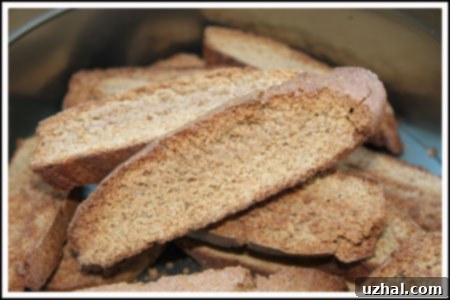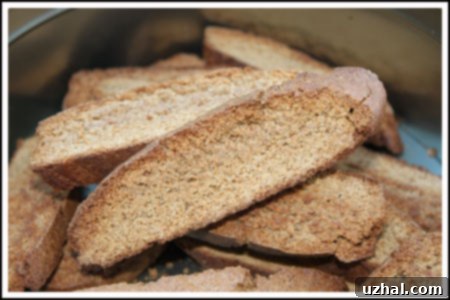The Ultimate Guide to Gingerbread Biscotti: Crafting the Perfect Spicy Crunch
The journey into the world of biscotti, specifically cantuccini, continues to be a delightful obsession in my kitchen. Just a few days ago, the irresistible aroma of another freshly baked batch filled my home, a testament to this ongoing fascination. This time, I decided to venture beyond the classic almond notes, seeking a more adventurous flavor profile. My chosen expedition led me to a recipe for “gingerbread biscotti” discovered on Allrecipes.com. The very act of baking these spicy delights not only filled the house with an incredibly comforting and festive scent but also yielded biscotti that were satisfying on so many levels. This initial foray into ginger-flavored variations has only solidified my determination to explore a multitude of recipes, all in pursuit of discovering that elusive, perfect “ginger-flavored biscotti.”
While this particular recipe was undeniably good, it didn’t quite hit the mark of perfection for my personal taste. My first immediate observation was the absence of nuts. For me, nuts, especially almonds, are an almost indispensable component of traditional biscotti. They provide a crucial textural contrast, a satisfying crunch that complements the inherent firmness of the cookie, and a subtle richness that enhances the overall flavor experience. Without them, I found myself missing that characteristic depth and bite that I’ve come to associate with truly great biscotti. It’s a small detail, but one that significantly impacts the perceived quality and enjoyment of each piece.
Furthermore, I harbored mixed feelings about the use of oil in this specific recipe. While it certainly contributed to a softer, more pliable biscotti, making it considerably easier to bite into, it simultaneously diminished a particular aspect of the biscotti experience that I’ve grown to appreciate. There’s a certain delightful suspense, a moment of anticipation, that accompanies the first bite of the harder, more traditional, no-fat variety of biscotti. That slight uncertainty, the question of “Will I break a tooth, or won’t I?” before the satisfying snap, is something I’ve surprisingly come to cherish. For years, I adored biscotti made with oil or butter, enjoying their more tender crumb. However, my palate has distinctly shifted, developing a profound fondness for the robust, almost challenging hardness of the classic, twice-baked variety. This journey of taste has led me to prefer the unyielding crunch, the kind that demands a confident dunk into a hot beverage to soften it just so.
Despite these minor quibbles, the foundational flavors of this gingerbread biscotti recipe were commendable. However, I wholeheartedly recommend a small but significant adjustment: the addition of salt. I found that a little over a quarter teaspoon was sufficient to elevate the overall flavor profile, balancing the sweetness and making the spices pop more vibrantly. Additionally, purely for the adventurous palate and to truly enhance the inherent spiciness of gingerbread, I introduced a quarter teaspoon of cayenne pepper. This isn’t for an overt fiery kick, but rather to provide a subtle, warming background heat that complements the ginger, cinnamon, and molasses beautifully, adding another layer of complexity to the spice blend without overpowering the primary flavors.

My ongoing “biscotti obsession” stems from several key aspects that make these Italian cookies so appealing. Beyond their delightful flavor, biscotti possess a unique charm rooted in their versatility and tradition. They are the quintessential companion to coffee, tea, or even a glass of vin santo, designed specifically for dipping. This characteristic not only softens their famously crisp texture but also allows them to absorb the nuanced flavors of the accompanying beverage, creating a truly harmonious culinary experience. Furthermore, their twice-baked nature grants them an impressive shelf life, making them ideal for gifting, meal prepping, or simply keeping a stash on hand for those moments when a sophisticated, yet simple, sweet treat is desired.
The transition from traditional almond biscotti to this gingerbread variant highlights the incredible adaptability of the biscotti form. While almond remains a timeless classic, the possibilities for flavor innovation are boundless. Gingerbread, with its rich tapestry of spices, is a particularly inspired choice for biscotti. The robust and sturdy structure of the cookie provides an excellent canvas for the bold flavors of ginger, molasses, cinnamon, cloves, and nutmeg. These spices, when combined, evoke a sense of warmth, comfort, and festive cheer, making gingerbread biscotti a perfect indulgence during cooler months or as a unique twist on a year-round favorite. The molasses, in particular, contributes a deep, caramelized sweetness and a subtle chewiness that complements the crunch beautifully.
For those aspiring to bake the perfect batch of biscotti, whether gingerbread or any other flavor, attention to detail throughout the baking process is paramount. The journey begins with selecting high-quality ingredients – fresh, aromatic spices make all the difference in a gingerbread recipe. When mixing the dough, avoid overworking it; gently combine the ingredients until just incorporated to prevent tough biscotti. Shaping the dough into uniform logs is crucial for even baking. Aim for logs that are roughly the same thickness and width, ensuring that each slice receives consistent heat during both baking stages. The first bake should render the logs firm to the touch but not overly browned; they should still have a slight give. After the first bake, allow the logs to cool slightly before slicing. This brief cooling period helps prevent crumbling and ensures clean, precise cuts. A sharp, serrated knife is your best friend here. Finally, the second bake, often at a lower temperature, is where the magic happens. This slow, gentle drying process is what imbues biscotti with their characteristic crispness and extends their shelf life. Ensure they are thoroughly dried out to achieve that satisfying snap. Once cooled completely, store your homemade biscotti in an airtight container to maintain their freshness and crisp texture for weeks.
My quest for the ultimate ginger-flavored biscotti is far from over. This initial attempt, while instructive, has merely whetted my appetite for further experimentation. Moving forward, I plan to meticulously scrutinize future recipes for several key elements. The reintroduction of nuts, perhaps toasted almonds or even pecans, is high on my priority list to restore that coveted textural complexity. I’ll also be experimenting with the fat content, comparing the nuances that butter brings versus oil, or even trying reduced-fat versions to see if I can achieve my preferred crispness without sacrificing flavor. Adjusting the spice levels will also be a fascinating exploration—finding that perfect balance of ginger, cinnamon, and molasses, perhaps even boosting the cayenne for an extra kick, will be key. Moreover, I envision incorporating additional elements like finely chopped candied ginger for an intense burst of flavor, delicate orange zest to brighten the spice profile, or a decadent drizzle of dark chocolate to add a sophisticated finish. Each batch represents a step closer to that perfect, personal ideal: a gingerbread biscotti that is not only robustly flavored and satisfyingly crunchy but also evokes the very essence of homemade warmth and culinary artistry.
